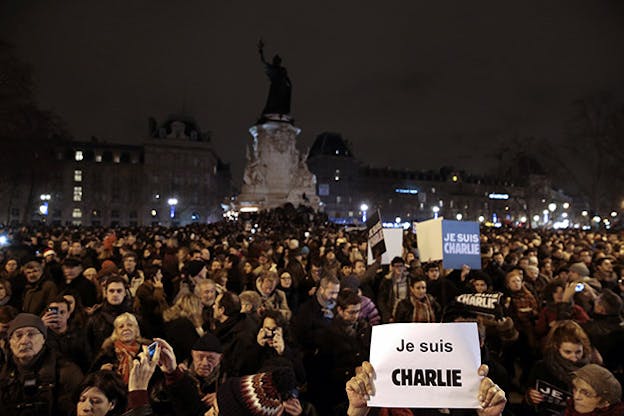Unusually for a column which is supposed to be a response to a single photograph, I wrote this before I selected the picture these words accompany. News agencies, the public—and history itself—all want defining images of events. Think of the massacre at the Munich Olympics in 1972 and you immediately see the figure in a balaclava on a balcony, framed by the brutalist architecture of the Olympic Village. Think of Tiananmen Square in 1989 and you see the protester standing in the path of a tank. This does not mean that only one image can define an event. In keeping with the inherent generosity of the medium, certain events generate multiple images, each of which is defining in its own way. September 11, 2001 was defined by images from multiple sources.

The defining quality of some events, however, is that they fail to generate defining images. This is true of the recent terrorist attacks in Paris and their aftermath. For a start, there were multiple attacks, spread over several days, leading to a near-simultaneous double denouement. This meant, for security forces and news photographers alike, that it was impossible to focus on a single event or location. Images of the key episodes were inevitably taken from a distance: gunmen filmed from a rooftop as they left the Charlie Hebdo offices, commandos on the roof of the printing works, the massed ranks of Special Forces shuffling their way along the windows of the kosher supermarket. Often the images were grabbed from moving footage shot by citizens who happened to be around as the action unfolded. One such image, showing the execution of police officer Ahmed Merabet, was too horrific to be printed or broadcast unless the incident at its center was blurred or pixilated beyond recognition. All of which can be taken as collateral proof of how the events in Paris proved so definitively image-resistant.
This was appropriate since the issues involved were more complex than the global expression of solidarity—Je Suis Charlie—could convey. In the absence of a picture, however, this irritating slogan whooshed into the vacuum so that the words— i.e. photographs of the badges, banners and stickers printed with the words, or of monuments with the words projected onto them—became the picture. This, too, was appropriate since Charlie Hebdo was a puerile magazine that ended up punching way above its weight. Judged purely aesthetically, the monuments of Paris looked far better with Nazi flags flying from them than they do with Je Suis Charlie lit up on them. Is that offensive? Not to me it’s not, Charlie. And don’t forget: Vous n’êtes pas Charlie seulement quand ça vous convient le mieux!
At the risk of giving further offense, wasn’t there a strong sense that, after years of being regarded as a bit of a backwater, after surrendering the title of European cultural HQ to London or Berlin, after the myth of the excellence of Parisian cuisine had been steadily eaten away, after a widespread feeling that Paris was in danger of becoming an urban mausoleum … after all this, wasn’t there an almost triumphant sense that both city and nation had been handed an unbeatable opportunity to reclaim their place at the leading edge of the enlightenment, to rebrand themselves as the birthplace of the modern? It’s just a shame there was no photograph to prove it.
